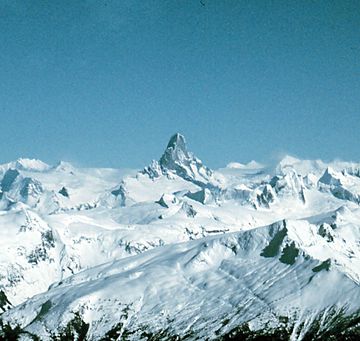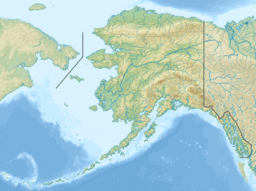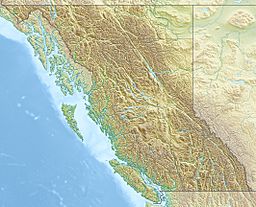Devils Thumb facts for kids
Quick facts for kids Devils Thumb |
|
|---|---|
 |
|
| Highest point | |
| Elevation | 9,077 ft (2,767 m) |
| Geography | |
| Parent range | Stikine Icecap, Boundary Ranges |
| Topo map | USGS Sumdum A-2 NTS 104F/01 |
| Climbing | |
| First ascent | 1946 by Fred Beckey, Clifford Schmidtke, Bob Craig |
| Easiest route | rock/snow/ice climb |
Devils Thumb, also known as Taalkhunaxhkʼu Shaa in the Tlingit language, is a tall mountain. It sits on the border between Alaska in the U.S. and British Columbia in Canada. This mountain looks like a giant thumb, which is how it got its name. In Tlingit, its name means "the mountain that never flooded." People say it was a safe place during a big flood long ago. It's also called Boundary Peak 71 on maps. Climbing Devils Thumb is very hard, even for expert climbers.
Where is Devils Thumb Located?
Devils Thumb is found in the Stikine Icecap area. This icecap is a huge sheet of ice. It sits on top of the Boundary Ranges. These ranges are part of the Coast Mountains. The mountains stretch across the border between Canada and the United States. Other tough peaks nearby include the Witches and Cat's Ears Spires. There are also Mount Burkett and Burkett Needle. These are about 8 miles (13 km) to the northeast.
What Makes Devils Thumb Special?
The most famous part of Devils Thumb for climbers is its Northwest Face. This huge rock face rises about 6,700 feet (2,042 meters). It goes up at a steep angle of 67 degrees. This makes it the biggest rock face in all of North America. The weather conditions there are often very bad. This makes it one of the most dangerous climbs on the continent.
Who First Climbed Devils Thumb?
The first time anyone climbed Devils Thumb was a big moment. It happened in 1946. Three climbers named Fred Beckey, Clifford Schmidtke, and Bob Craig made the first ascent. They climbed the East Ridge. This route was very difficult for its time. It was also far away from help. The weather was often terrible.
Many climbers have tried to conquer the Northwest Face. It is a huge wall with bad weather and tricky rock. There can also be dangerous ice and avalanches. It is known as a very risky and difficult climb. It is rarely in good condition for climbing.
In 1977, a famous writer named Jon Krakauer climbed the East Ridge. He wrote about his experience in his book Eiger Dreams, Ventures Among Men and Mountains. Krakauer also wrote about his solo climb of Devils Thumb in his book Into the Wild.



